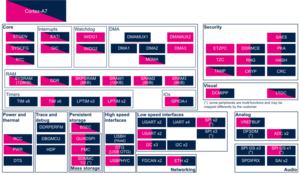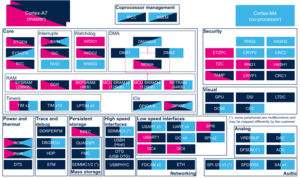Registered User |
Registered User mNo edit summary |
||
| Line 54: | Line 54: | ||
|} | |} | ||
===== On {{MicroprocessorDevice | device=15}} ===== | ===== On {{MicroprocessorDevice | device=15}} ===== | ||
{{: | {{:STM32MP15_internal_peripherals_software_table_template}} | ||
| Core/DMA | | Core/DMA | ||
| [[DMA internal peripheral|DMA]] | | [[DMA internal peripheral|DMA]] | ||
| Line 91: | Line 91: | ||
|} | |} | ||
===== On {{MicroprocessorDevice | device=15}} ===== | ===== On {{MicroprocessorDevice | device=15}} ===== | ||
{{: | {{:STM32MP15_internal_peripherals_assignment_table_template}} | ||
<section begin=stm32mp15 /> | <section begin=stm32mp15 /> | ||
| rowspan="2" | Core/DMA | | rowspan="2" | Core/DMA | ||
Revision as of 14:59, 1 February 2022
1. Article purpose[edit | edit source]
The purpose of this article is to:
- briefly introduce the DMA peripheral and its main features
- indicate the level of security supported by this hardware block
- explain how each instance can be allocated to the runtime contexts and linked to the corresponding software components
- explain, when necessary, how to configure the DMA peripheral.
2. Peripheral overview[edit | edit source]
The DMA peripheral is used to perform direct accesses from/to a device or a memory. Each DMA instance supports 8 channels. The selection of the device connected to each DMA channel and controlling the DMA transfers is done via the DMAMUX.
Note: Directly accessing DDR from the DMA is not recommended for high-bandwith or latency-critical transfers. This means that DMA transfers configured by the Arm® Cortex®-A7 operating system, that usually target buffers in external memory, require a hardware mechanism to chain the DMA and a MDMA channel in order to achieve the following flow:
- DDR<-> MDMA <-> MCU SRAM <-> DMA <-> device
This feature was already present on STM32H7 microcontroller Series. It is documented in application note AN5001[1].
2.1. Features[edit | edit source]
Refer to the STM32MP13 reference manuals or STM32MP15 reference manuals for the complete list of features, and to the software components, introduced below, to see which features are implemented.
2.2. Security support[edit | edit source]
2.2.1. On STM32MP13x lines  [edit | edit source]
[edit | edit source]
DMA1 and DMA2 instances are non-secure peripherals. DMA3 is a secure peripheral.
2.2.2. On STM32MP15x lines  [edit | edit source]
[edit | edit source]
DMA1 and DMA2 instances are non-secure peripherals.
3. Peripheral usage and associated software[edit | edit source]
3.1. Boot time[edit | edit source]
The DMA is not used at boot time.
3.2. Runtime[edit | edit source]
3.2.1. Overview[edit | edit source]
3.2.1.1. On STM32MP13x lines  [edit | edit source]
[edit | edit source]
DMA1 and DMA2 can be assigned to the Arm® Cortex®-A7 non-secure context to be controlled in Linux® by the dmaengine framework.
DMA3 can be assigned to the Arm® Cortex®-A7 secure context, to be controlled by a DMA OP-TEE driver, not supported yet by OpenSTLinux.
3.2.1.2. On STM32MP15x lines  [edit | edit source]
[edit | edit source]
Each DMA instance can be allocated to:
- the Arm® Cortex®-A7 non-secure core to be controlled in Linux® by the dmaengine framework
or
- the Arm® Cortex®-M4 to be controlled in STM32Cube MPU Package by the DMA HAL driver
3.2.2. Software frameworks[edit | edit source]
3.2.2.1. On STM32MP13x lines  [edit | edit source]
[edit | edit source]
| Domain | Peripheral | Software components | Comment | |
|---|---|---|---|---|
| OP-TEE | Linux | |||
| Core/DMA | DMA | OP-TEE DMA driver | Linux dmaengine framework | |
3.2.2.2. On STM32MP15x lines  [edit | edit source]
[edit | edit source]
| Domain | Peripheral | Software components | Comment | ||
|---|---|---|---|---|---|
| OP-TEE | Linux | STM32Cube | |||
| Core/DMA | DMA | Linux dmaengine framework | STM32Cube DMA driver | ||
3.2.3. Peripheral configuration[edit | edit source]
The configuration is applied by the firmware running in the context to which the peripheral is assigned. The configuration can be done alone via the STM32CubeMX tool for all internal peripherals, and then manually completed (particularly for external peripherals), according to the information given in the corresponding software framework article.
3.2.4. Peripheral assignment[edit | edit source]
3.2.4.1. On STM32MP13x lines  [edit | edit source]
[edit | edit source]
Check boxes illustrate the possible peripheral allocations supported by STM32 MPU Embedded Software:
- ☐ means that the peripheral can be assigned (☑) to the given runtime context.
- ⬚ means that the peripheral can be assigned to the given runtime context, but this configuration is not supported in STM32 MPU Embedded Software distribution.
- ✓ is used for system peripherals that cannot be unchecked because they are statically connected in the device.
Refer to How to assign an internal peripheral to a runtime context for more information on how to assign peripherals manually or via STM32CubeMX.
The present chapter describes STMicroelectronics recommendations or choice of implementation. Additional possiblities might be described in STM32MP13 reference manuals.
| Domain | Peripheral | Runtime allocation | Comment | ||
|---|---|---|---|---|---|
| Instance | Cortex-A7 secure (OP-TEE) |
Cortex-A7 non-secure (Linux) | |||
| Core/DMA | DMA | DMA1 | ☐ | Assignment (single choice) | |
| DMA2 | ☐ | Assignment (single choice) | |||
| DMA3 | ⬚ | Assignment (single choice) | |||
3.2.4.2. On STM32MP15x lines  [edit | edit source]
[edit | edit source]
Check boxes illustrate the possible peripheral allocations supported by STM32 MPU Embedded Software:
- ☐ means that the peripheral can be assigned (☑) to the given runtime context.
- ✓ is used for system peripherals that cannot be unchecked because they are statically connected in the device.
Refer to How to assign an internal peripheral to a runtime context for more information on how to assign peripherals manually or via STM32CubeMX.
The present chapter describes STMicroelectronics recommendations or choice of implementation. Additional possiblities might be described in STM32MP15 reference manuals.
| Domain | Peripheral | Runtime allocation | Comment | |||
|---|---|---|---|---|---|---|
| Instance | Cortex-A7 secure (OP-TEE) |
Cortex-A7 non-secure (Linux) |
Cortex-M4 (STM32Cube) | |||
| Core/DMA | DMA | DMA1 | ☐ | ☐ | Assignment (single choice) | |
| DMA2 | ☐ | ☐ | Assignment (single choice) | |||
4. References[edit | edit source]

